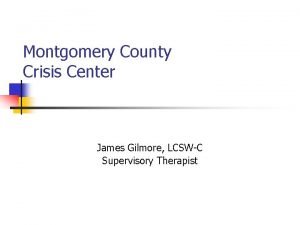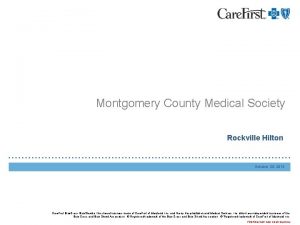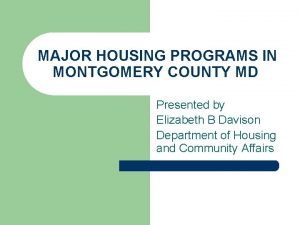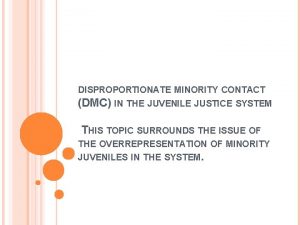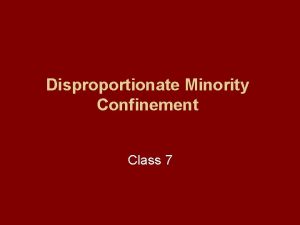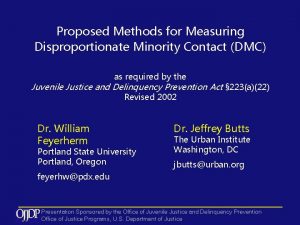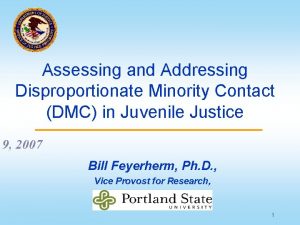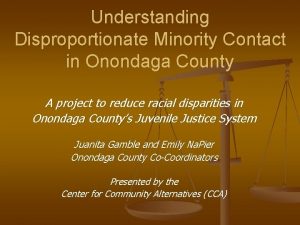MONTGOMERY COUNTY DISPROPORTIONATE MINORITY CONTACT DMC PILOT JUVENILE











- Slides: 11

MONTGOMERY COUNTY DISPROPORTIONATE MINORITY CONTACT (DMC) PILOT JUVENILE DIVERSION PROGRAM M O N T G O M E R Y C O U N T Y A N G E L A B E L L , E S Q U I R E R J I P T A S K F O R C E F A C I L I T A T O R D I S P R O P O R T I O N A T E M I N O R I T Y C O N T A C T C O O R D I N A T O R

MONTGOMERY COUNTY RJIP TASK FORCE MEMBERS The Honorable William Furber, President Judge Montgomery County Court of Common Pleas The Honorable Christopher J. Cerski, Magisterial District Judge The Honorable Risa Ferman, Montgomery County District Attorney Ms. Sharon Giamporcaro, Deputy District Attorney, Juvenile Division Mr. Steven Custer, Chief Juvenile Probation Officer Kelly Brown, Director of Prevention Services Family Service of Montgomery County

MONTGOMERY COUNTY RJIP TASK FORCE MEMBERS The Honorable Kier Bradford-Grey, Chief Public Defender Chief Thomas Nolan, Upper Merion Police Department Ms. Angela Bell, Esquire, Montgomery County DMC Coordinator RJIP Task Force Facilitator Mr. Thomas Haney, Youth Aid Panel Administrator Montgomery County District Attorney’s Office Ms. Ann Kanof, Information Specialist

WHAT IS THE SPECIFIC DISPARITY YOUR TASK FORCE HAS IDENTIFIED? q The specific racial disparity the task force has identified is the overrepresentation and Disproportionate Minority contact of black juveniles at the arrest stage. q This problem was identified through statewide DMC data provided by the Pennsylvania Commission on Crime and Delinquency and the Center for Juvenile Justice Training and Research. q The task force chose this issue because local DMC RRI arrest data indicates significant racial disparity in 10 jurisdictions across Montgomery County with regard to the arrest of black juveniles. q The task force believes that this issue can be effectively addressed through a combination of the Youth Aid Panel diversionary program, training/education for law enforcement, in addition to a partnership and collaboration with Family Services of Montgomery County and District Attorney’s office.

WHAT IS THE PROPOSED RACIAL JUSTICE POLICY REFORM THAT YOUR TASK FORCE HAS DEVELOPED TO ADDRESS THIS DISPARITY? • The District Attorney created the Youth Aid Panel (YAP) to divert certain qualifying summary and misdemeanor offenders from the criminal justice system. Despite the existence of YAP, the Montgomery County DMC RRI arrest data indicates significant racial disparity in 10 Montgomery County jurisdictions. The committee identified three policy changes to YAP that will help divert more minority juveniles into YAP and consequently lower DMC arrest data. • YAP Eligibility Criteria: The new criteria/policy permits a juvenile to complete YAP despite the juvenile possessing two prior summary convictions and prior YAP referral, one prior adjudication of delinquency on a misdemeanor offense, or a pending dependency matter. • Case management services: YAP possesses no case/offender management service to assist juvenile offenders in successfully completing the diversionary program. Case management services will be provided by Montgomery County Family Services. The case management services will assist the juvenile offender in successfully completing the YAP panel’s restorative disposition. • Discretionary referral process: Law enforcement possesses the sole discretion to refer or not refer a juvenile offender to YAP. Because the case management policy change will be focused in Upper Merion Township, the Upper Merion Chief of Police agreed to implement a more objective referral process. Specifically, Upper Merion will refer all summary retail theft juvenile offenders meeting the YAP eligibility criteria. This policy change eliminates officer discretion.

HOW DO YOU PLAN TO IMPLEMENT THIS REFORM? • The policy amendments will be implemented as follows: • Step #1: On July 22, 2014, the District Attorney amended the YAP eligibility criteria to include offenders previously convicted of two summary offenses, adjudicated delinquent for a misdemeanor offense, or subject to a pending dependency petition. • Step #2: Upper Merion Police Department directs all officers to refer all juvenile offenders who live in zip code 19401 to YAP that meet the eligibility criteria. Upper Merion Police Department will refer to YAP minority juveniles accused of summary retail theft. • Step #3: Family Services will develop an evaluation tool for use by YAP when deciding whether case management will be ordered. • Step #4: The Norristown YAP will be trained concerning the use of case management services. The Norristown YAP will accept a maximum of 30 juveniles accused of retail theft from the Upper Merion Police Department. The Norristown YAP will order half the juveniles to complete YAP with case management and half the juveniles to complete YAP without case management. This will be achieved by alternating every other arrest in the pilot program.

HOW DO YOU PLAN TO IMPLEMENT THIS REFORM? CONT’D • The policy amendments cont’d: • Step #5: The non-case management juveniles will complete YAP under traditional circumstances. The case management juveniles will be contacted by Family Services and assisted throughout the YAP restorative process. • Step #6: At the YAP follow-up meeting, the panel will determine if the juvenile successfully completed the program. • Step #7 A: If the juvenile successfully completes the program, then no “arrest” will occur or initiation of court process. The Public Defender’s Office will assist the juvenile in expunging any pre-arrest records retained by the Upper Merion Police Department. • Step #7 B: If the juvenile fails to complete YAP, then Upper Merion Police Department will formally charge the juvenile and initiate court proceedings.

HOW DO YOU PLAN TO IMPLEMENT THIS REFORM? CONT’D • The policy amendments cont’d: • Step #8: Post Program Research • Committee will evaluate the effect of the eligibility criteria on DMC countywide. • Committee will evaluate the effect of case management versus no case management on YAP completion and DMC. • Committee will evaluate the effect of the Upper Merion Police Department referral policy change versus other county police departments and any correlation to DMC. • Committee will evaluate success rates of the YAP participants with priors and how the statistics correlate to DMC. • Committee will evaluate recidivism rates of the 30 juvenile retail theft offenders referred to YAP for a period of two years.

HOW DO YOU PLAN TO TRACK AND MEASURE THE EFFECTIVENESS OF YOUR PROPOSED RACIAL JUSTICE POLICY REFORM? • A three-pronged approach (aggregate, individual & policy) will be taken to determine the effectiveness of the alternative adjudication program the task force is proposing (i. e. Case Management as a part of the Youth Aid Panel (YAP)). • Therefore the first prong of the approach will be to collect baseline data for 2011, 2012, 2013 on retail theft for African Americans arrested in Upper Merion Township. From this data, a Relative Risk Index (RRI) will be calculated for each year. • The second prong will address the individual. The task force will check 6 month recidivism rates up to 2 years after they have completed the program for each participant. This will be compared to a matched control group of youth not receiving Case Management. The control group will also be used to compare YAP completion rates.

HOW DO YOU PLAN TO TRACK AND MEASURE THE EFFECTIVENESS OF YOUR PROPOSED RACIAL JUSTICE POLICY REFORM? • The control group will consist of every other person being referred to YAP for retail theft. They will not receive case management. The current practice is for participants to not receive any case management. • For this project a change in criteria for inclusion in YAP was made. Data will be collected for 2 years prior to this policy change to show a picture of number of referrals and will be compared to the number of referrals during the year of this project.

NEXT STEPS • The task force will create marketing/educational materials regarding the diversion program for youth, parents and law enforcement. • Disseminate program updates and outcomes to policy makers in the criminal justice system and community groups. • Host a DMC/Juvenile Justice Summit to provide education and training on DMC and juvenile justice issues. • Seek additional funding to support the DMC Coordinator position. • Expand our partnership with the ABA and the Pennsylvania Commission on Crime and Delinquency (PCCD) to continue our efforts beyond the grant period and institutionalize the work of the task force.
 Dmc debt management contact number
Dmc debt management contact number Disproportionate dwarfism pictures
Disproportionate dwarfism pictures Disproportionate representation definition
Disproportionate representation definition Jenis jenis sampel
Jenis jenis sampel Montgomery county crisis center
Montgomery county crisis center Grat trust
Grat trust Montgomery county medical society
Montgomery county medical society Mpdu montgomery county md
Mpdu montgomery county md Smoke detector repair montgomery county
Smoke detector repair montgomery county Rockville mpdu
Rockville mpdu Montgomery county ethics commission
Montgomery county ethics commission Montgomery county md
Montgomery county md




